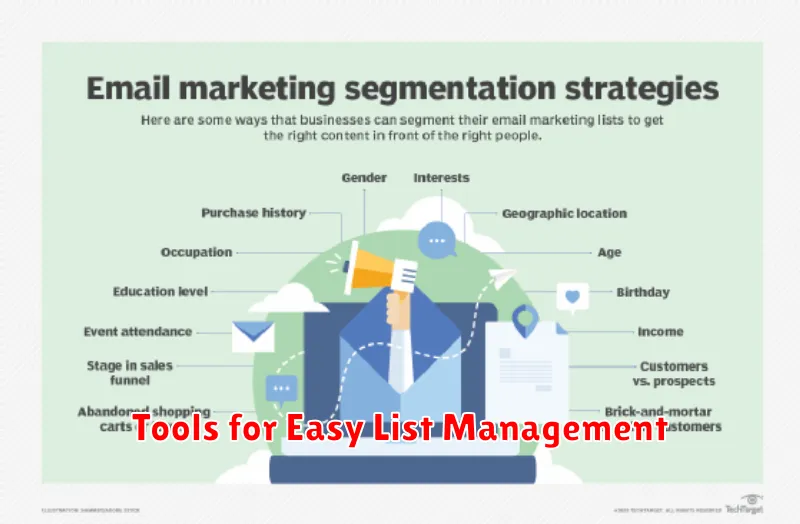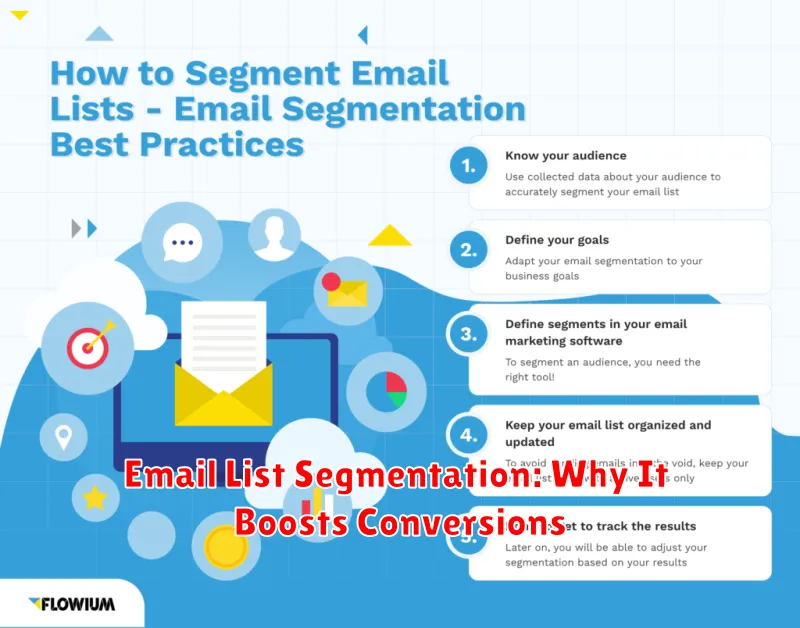Email list segmentation is a powerful strategy that allows you to divide your subscribers into smaller, more targeted groups based on shared characteristics. This allows you to send more relevant and personalized email campaigns, rather than a one-size-fits-all approach. By tailoring your messaging to specific segments, you can significantly improve your email marketing results and boost your conversions. Understanding the importance of email list segmentation and its impact on your conversion rates is crucial for maximizing your email marketing ROI. Effective segmentation helps you avoid sending generic emails that might be irrelevant to a large portion of your audience, leading to higher engagement and ultimately, more conversions.
This article will delve into the reasons why email list segmentation is essential for boosting conversions. We’ll explore the benefits of sending targeted emails to specific segments of your audience and how this personalization can lead to increased open rates, click-through rates, and ultimately, higher conversion rates. Learn how to leverage email list segmentation to cultivate stronger customer relationships, reduce unsubscribe rates, and drive significant improvements in your overall email marketing performance and achieve a higher ROI. Discover how proper segmentation can transform your email campaigns from generic blasts into personalized communications that resonate with your audience and drive the desired actions.
What Is Email Segmentation?
Email segmentation is the practice of dividing your email subscriber list into smaller, more targeted groups based on shared characteristics. This allows you to send more relevant and personalized emails to each segment, rather than a generic message to your entire list. By tailoring your messaging to specific interests, demographics, or behaviors, you dramatically increase the effectiveness of your email marketing campaigns.
Some common criteria used for segmentation include demographics (age, location, gender), purchase history, website activity (pages visited, products viewed), email engagement (open rates, click-through rates), and lead source. Effective segmentation improves open rates, click-through rates, and conversions, while simultaneously reducing unsubscribe rates and spam complaints. Ultimately, it allows you to nurture stronger relationships with your subscribers by providing them with content they actually want to receive.
Using segmentation allows businesses to achieve a variety of positive outcomes. These can include increasing brand loyalty, improving customer lifetime value, driving more sales, and promoting specific products or services to the right audience. By understanding your audience segments and tailoring your message accordingly, you can achieve significantly higher returns on your email marketing investment.
Why Segmentation Increases Engagement
Segmentation is the process of dividing your audience into smaller, more manageable groups based on shared characteristics. This allows you to tailor your messaging and offers to resonate more deeply with each specific segment, rather than relying on a generic, one-size-fits-all approach. By addressing the specific needs, interests, and pain points of each group, you create content and experiences that are more relevant and engaging. This heightened relevance leads to increased open rates, click-through rates, and ultimately, conversions.
Consider a company selling athletic wear. Instead of sending the same email promoting running shoes to everyone, they could segment their audience based on preferred activities. One segment might be runners, receiving emails about the latest running shoes and training tips. Another segment could be hikers, receiving emails about hiking boots and trail guides. This targeted approach avoids overwhelming customers with irrelevant information and instead provides them with content they actually find valuable.
By focusing your efforts on delivering the right message to the right audience at the right time, you foster a stronger connection and build more meaningful relationships. This personalized experience demonstrates that you understand your customers and value their individual preferences. This, in turn, cultivates loyalty and drives higher engagement across all platforms.
Types of Segmentation (Demographic, Behavior, etc.)
Market segmentation divides a broad consumer market into smaller, more homogeneous groups based on shared characteristics. This allows businesses to tailor their marketing efforts to specific needs and preferences, improving effectiveness. Common segmentation bases include demographic (age, gender, income, education), geographic (location, climate, population density), psychographic (lifestyle, values, personality), and behavioral (usage rate, brand loyalty, purchase occasion).
Demographic segmentation is widely used due to its readily available data and ease of measurement. Age and gender are particularly common, influencing product preferences, purchasing power, and media consumption. Income and education levels further refine these segments, enabling targeting based on affordability and sophistication. Geographic segmentation allows businesses to customize their offerings to specific regions or even micro-locations, accounting for local cultural nuances and environmental factors.
Psychographic segmentation provides a deeper understanding of consumer motivations by examining their lifestyle, values, and personality traits. This enables businesses to connect with customers on an emotional level and build stronger brand affinity. Behavioral segmentation focuses on how consumers interact with products or services, considering factors like usage frequency, purchase occasion, and brand loyalty. Understanding these patterns helps tailor messaging, promotions, and product development to maximize customer engagement and lifetime value.
Tools for Easy List Management

Managing lists effectively is crucial for productivity in various aspects of life, from work projects to personal errands. Fortunately, numerous tools exist to simplify this process. These tools often offer features such as task prioritization, deadline setting, collaboration options, and progress tracking. Choosing the right tool depends on individual needs and the complexity of the lists being managed.
For simple task management, basic to-do list apps on smartphones or built-in features within email clients can suffice. These options allow for quick creation of lists and checking off completed items. For more complex projects, dedicated project management software provides robust features like Gantt charts, Kanban boards, and team communication tools. These tools are ideal for collaborative efforts and projects with multiple dependencies.
Ultimately, the key to easy list management is finding a tool that fits your workflow and offers the necessary features without being overly complicated. Experimenting with different options can help determine the best fit for individual needs. Consider factors such as ease of use, accessibility across devices, and integration with other applications you frequently use.
Examples of Targeted Campaigns
Targeted campaigns focus on reaching specific demographics or interest groups with tailored messaging. For example, a clothing retailer might target young adults interested in sustainable fashion with ads showcasing their organic cotton line. This precision allows for more efficient use of marketing budgets and increases the likelihood of conversions by addressing the specific needs and desires of the target audience.
Another example could be a software company promoting a new project management tool. They might target businesses with 50-200 employees via LinkedIn, emphasizing the software’s ability to streamline workflows and improve team collaboration. This focus ensures that the message reaches the decision-makers most likely to benefit from and purchase the software.
Political campaigns frequently employ targeted strategies. A candidate might target undecided voters in a specific swing district with messages addressing their key concerns, such as local economic development or healthcare access. This concentrated outreach can be crucial for swaying public opinion and winning elections.
How to Gather Segmentation Data
Gathering effective segmentation data requires a multi-faceted approach. First-party data, collected directly from your customers through website interactions, surveys, CRM systems, and purchase history, provides valuable insights into their behavior and preferences. Supplement this with second-party data, which is essentially another company’s first-party data that you acquire through partnerships. Finally, consider using third-party data purchased from data aggregators to expand your reach and fill in gaps in your understanding of broader market trends.
Focus on collecting data that aligns with your business goals. If you’re an e-commerce business, crucial data points might include purchase frequency, average order value, and product browsing history. For a SaaS company, usage data, customer churn rate, and feature adoption metrics are more relevant. Remember to prioritize data quality over quantity. Inaccurate or incomplete data can lead to flawed segmentation and ineffective marketing campaigns.
Ensure compliance with data privacy regulations, such as GDPR and CCPA, throughout the collection process. Be transparent with customers about how their data will be used and provide them with control over their data preferences. This builds trust and reinforces a positive brand image.
Maintaining Clean Segments Over Time
Maintaining clean data segments is crucial for effective marketing and analysis. Over time, customer behavior changes, new data becomes available, and inaccuracies can creep in. Regularly reviewing and updating your segmentation criteria ensures your segments remain relevant and actionable. This might involve adjusting the rules based on recent purchase history, website activity, or demographic shifts. Consistent data hygiene practices, such as deduplication and address verification, also contribute to segment integrity.
Automating segment updates can significantly improve efficiency. By implementing dynamic segmentation, you can define rules that automatically add or remove individuals based on real-time data. This ensures your segments are always up-to-date and reflect the latest customer information. For example, you could set up a rule that automatically adds a user to a “high-value customer” segment once they reach a certain spending threshold.
Regularly evaluating segment performance is essential to maximizing their value. Monitor key metrics like conversion rates, engagement, and customer lifetime value for each segment. If a segment is underperforming, revisit the criteria and make adjustments as needed. This ongoing optimization process ensures your segments remain aligned with your business goals and contribute to achieving desired outcomes.
Dynamic Content for Each Segment
Targeted content is crucial for effective marketing. By segmenting your audience, you can tailor your message to resonate with specific groups, increasing engagement and conversions. This means understanding your audience’s needs, preferences, and pain points, and crafting content that directly addresses them.
Consider segmenting by demographics, buying behavior, or engagement level. For example, a new customer might receive onboarding materials, while a loyal customer could get exclusive offers. Analyzing data and using analytics tools can help identify these segments and inform content creation.
Ultimately, dynamic content ensures the right message reaches the right person at the right time, driving meaningful interactions and building stronger relationships with your audience.
A/B Testing Segment-Specific Content
A/B testing segment-specific content involves creating two or more variations of content tailored to specific user groups. This could be based on demographics, behavior, or other defining characteristics. By presenting different variations to each segment, you can determine which version resonates most effectively with each group, leading to improved engagement, conversion rates, and overall user experience.
Key benefits of this approach include increased personalization, allowing you to deliver more relevant messages, and improved targeting efficiency by optimizing content for individual segments. This method requires careful segmentation and analysis to ensure the groups are distinct and the results are meaningful. It’s crucial to define clear metrics for success, such as click-through rates, conversion rates, or time spent on page, before beginning the test.
Running A/B tests on segmented content can reveal valuable insights into how different user groups interact with your content. This data-driven approach empowers you to make informed decisions about your content strategy and optimize for maximum impact within each target segment.
Measuring Results by Segment

Segmenting your audience allows for a more granular analysis of marketing campaign performance. By dividing your audience into relevant groups based on demographics, behavior, or other characteristics, you can measure how each segment responds to specific initiatives. This provides valuable insights into which campaigns resonate with different audiences and allows you to optimize future efforts for maximum impact.
Key metrics to track by segment can include conversion rates, engagement rates (such as clicks, opens, and shares), and return on investment (ROI). Comparing these metrics across segments highlights areas of strength and weakness. For example, you might discover that a particular campaign has a high ROI in one segment but performs poorly in another. This information helps you refine targeting and messaging to improve overall results.
By continually analyzing results by segment, you can refine your marketing strategies and allocate resources more effectively. This data-driven approach leads to improved campaign performance and a better understanding of your target audience.

